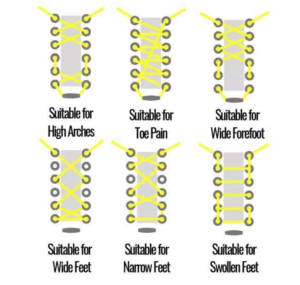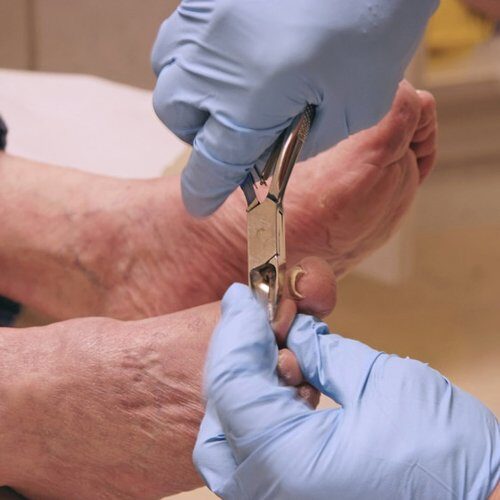Foot Pain – What You Need To Know
 If we have uncomfortable feet, it affects every aspect of our lives. Chronic foot pain can be very depressing.
If we have uncomfortable feet, it affects every aspect of our lives. Chronic foot pain can be very depressing.
Foot pain can be due to lifestyle choices, medical conditions or trauma. If you’re in pain your GP is likely to be your first port of call, more and more people are realising they should be seeing a podiatrist if they have foot pain.
Lifestyle choices affecting your feet often to boil down to footwear choice. Shoes are rarely foot shaped, most squash the toes preventing good toe function by preventing some foot muscles from working efficiently. Some foot types can resist the deforming influences of fashion better than others.
A sudden change in activity levels can be a major cause of foot pain, starting a new job, going from desk bound to on your feet all day is like going from Couch to 5K without the training. For sports people even a couple of weeks break from your usual regime can lead to decondition your muscles, you can’t expect to pick up again from where you left off.
The human foot has 26 bones, 33 joints and 107 muscles tendons and ligaments. Some people even have some extra bones called accessory ossicles. The foot is an amazing feat of engineering.
Any one of these structures can cause problems and foot pain.
Podiatrists can help with a wide variety of foot problems, sometimes it’s obvious what is wrong as it’s visible on the skin, a corn callus or verruca, maybe an ingrowing toenail. Often, it’s not that obvious, pain could be due to arthritis, overloading of a tendon or muscle, there may be a trapped nerve or even pain due to circulatory problems. Podiatrists are trained to detect problems in all of these areas and can also spot skin cancers.
We can help by identifying the cause of the pain, removing it, looking at causative factors and trying to prevent a recurrence of that pain. We may recommend a different style of shoe based on you foot type and your activity level. We may recommend exercises or stretching to improve your foot function and we may recommend orthoses.
Orthoses are insoles which we can use to alter the loading of your foot as you walk. Price varies depending on whether it’s a temporary insole, off the shelf or bespoke. We tend to recommend bespoke orthoses if they are needed long-term or if the foot shape is nonstandard, some people prefer to have bespoke insoles as they’re made to a scan of your foot which improves comfort and take up less room in your shoes.
Common Musculo-skeletal problems we see are plantar fasciitis, Morton’s neuroma, bunion’s, hammer toes and painful arches.
Plantar fasciitis is the most commonly diagnosed form of heel pain, but there are about 40 different causes of heel pain. It’s definitely worth seeing one of our podiatrists early on to make sure you are treating the right condition.
The plantar fascia acts like a tendon, if it is causing pain it needs to be offloaded to heal and then rehabbed to strengthen it as it is reloaded. We will look at your foot structure, strength of various muscles groups your general posture and your footwear. Bringing in old trainers so we can see gives us some good clues as to how your feet function.
Morton’s neuroma or Morton’s metatarsalgia is a common cause of pain in the forefoot often with sharp shooting pains going into your toes. Morton’s neuroma is common in dancers and anyone who has to wear smart shoes for work as they tend to be tight fitting.
Bunion’s and other toe problems often run in families, but can be caused by arthritis or injury to the toe, wearing the right footwear can make all the difference.
Many people are worried about flat feet. As long as flat feet aren’t painful there’s no problem.
All foot types benefit from the right footwear. You need a shoe which will fits correctly in length width and depth, your heel should stay securely in the back of the shoe, lace ups or shoes with a buckle or Velcro fastening are good for this. There should be plenty of space in front of your longest toe a minimum of half the width of your thumb, this allows space for the toes to move forward as you ‘toe off’ without putting pressure on your nails.
There are different lacing patterns which can help with different arch types:

Finally, match your footwear to the occasion as well as your outfit. If you’re going shopping wear something comfortable, if you’re on your feet all day wear something comfortable, if you’re going to be dancing the night away – wear something comfortable! Smart shoes for work should still be comfortable, your employer can’t insist you wear a certain style of shoe if they’re damaging your feet. The College of Podiatry tried to bring in new legislation about this a couple of years ago, the Government agreed but said there were laws already in place to cover this, think Sex Discrimination and Health and Safety at work. Safety footwear can cause problems especially if you already have a wide foot or overlapping toes, most firms will reimburse you if you need to buy your own.

